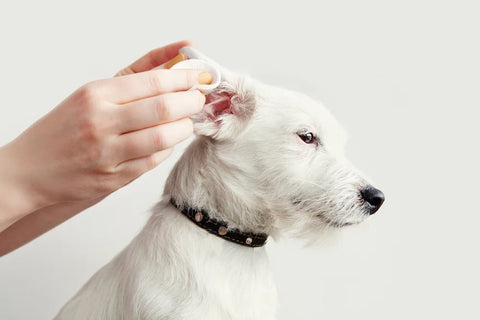

Ringworm in dogs
The name ringworm sounds unpleasant, and even a little scary. But did you know this skin complaint isn’t actually caused by a worm?
Less common than some other skin conditions, ringworm infection in dogs is a potential cause of itchy skin and hair loss and requires prompt treatment to prevent it from spreading to other pets or humans.
If you don’t know much about ringworm in dogs don’t worry, you’ll soon have all the facts. In this blog, we cover the causes and clinical signs, as well as treating dogs with ringworm. That way, you can feel more informed the next time you speak with your vet.
What is ringworm in dogs?
Ringworm infection in dogs is caused by a fungus that creates characteristic ring-like areas of skin irritation. The technical name for ringworm in puppies and dogs is dermatophytosis. It’s caused by microscopic fungi (dermatophytes) which can be spread by infected individuals or transferred via objects like clipper blades or bedding. These fungi multiply in warm, moist conditions, like already broken or inflamed skin.
Fungal skin conditions in dogs are usually avoided in individuals who have a healthy skin barrier.
Signs of ringworm in dogs
How do I know if my dog has ringworm? Dogs with ringworm may have some or all of the following symptoms:
- Circular patches of hair loss - these can start small and gradually increase in size over time.
- Skin irritation or redness – infected skin may become sore, inflamed or red
- Dry, crusty or flaky skin – this change in skin quality will be most obvious in the areas of hair loss.
- Fragile hairs – your dog’s hairs may come away or break more easily than usual. This can leave behind fur that looks like it has been clipped.
- Increased itchiness – secondary bacterial infection is a possible complication of ringworm in dogs. This can contribute to inflamed and itchy skin in dogs.
-
Rough or brittle claws – some affected dogs may have changes in their claws
What does ringworm look like on a dog?
Ringworm lesions can be variable in appearance but often look like circular patches of skin irritation. There may be crusting or dry skin present. The hairs may come away from this area more easily than normal, too.
How do dogs get ringworm?
Ringworm is caused by fungal spores getting into already moist or traumatised skin. Microtrauma, for example, from clipping during grooming, could be enough of a breach in the normal skin barrier to increase a dog’s risk of infection. Other risk factors include:
- Living in a warm environment
- Dogs that roam freely or hunt
- Underlying illness
- Living in overcrowded or unhygienic conditions
But remember, most healthy dogs with a good skin barrier are unlikely to become infected by contacting fungal spores.
How is ringworm in dogs diagnosed?
Your vet will first need to examine your dog and talk to you about their symptoms. They may then suggest tests which could include:
- Wood’s lamp – some types of fungi will glow or fluoresce under this handheld UV light, making this a useful screening tool
-
Fungal cultures – your vet may take samples from your dog’s skin and coat. These are then sent to the lab to be incubated in special growth media dishes. They are inspected to see if fungal spores grow
- Microscopy – examining your dog’s hair under magnification with a microscope could lead to a diagnosis in some cases
-
Polymerase Chain Reaction (PCR) – this laboratory technique amplifies the DNA in the provided sample, telling us if ringworm is present or not. This can give a quicker diagnosis than fungal culture

Treating dogs with ringworm
This condition is not life-threatening and, in some cases, will resolve without intervention. Ringworm treatment for dogs can help to shorten the duration of infection and reduce the risk of spread, however.
- Topical treatment – medicated shampoo, cream or ointment might be advised. In some cases, you may need to shave your dog’s fur so that the treatment can reach their skin more easily. Sometimes, topical treatment may need to be administered for several months before the infection completely clears
- Oral medications – these are sometimes needed in combination with topical treatments. Antifungal medicines like this may need to be taken for several weeks
- Decontaminating the environment – Spores are dormant and won’t multiply in the environment, so they can easily be removed through regular cleaning. This includes hoovering up visible loose hairs and debris, as well as washing any surfaces with disinfectant. Machine washing toys and bedding regularly is also recommended. Any shed hairs around your home could contain infectious material, so you might decide it’s easier to keep your dog in an easy-to-clean zone within your house
-
Testing and treating other animals – If you have other pets in your house, you may need to test and treat them as well
Ringworm in puppies and dogs can take a while to completely resolve. It’s important to follow your vet’s instructions closely, and make sure you do the full treatment course. Re-testing your dog at the end may be advised to make sure the infection has completely gone.
Remember to wash your hands after handling your dog. While ringworm infection in humans is uncommon, this condition is potentially zoonotic, which means it can be passed on. People with weaker immune systems, like children or the elderly, are more likely to catch it. Speak to your GP if you have any concerns.
How to prevent ringworm in dogs
Keeping your dog’s skin as healthy as possible is the most important way you can protect them against ringworm. This means having them on a high-quality complete diet, using regular anti-parasite products and considering using supplements to support your pet’s skin health, particularly if your pet is prone to skin issues, including skin allergies. Good home hygiene and avoiding contact with infected animals will also help.
Summary
Ringworm infection in dogs is often secondary to other issues, such as problems with the skin barrier. Once your vet has diagnosed the condition, they can recommend a plan for your pet.
Treating dogs with ringworm can take time, so it is important to be patient and follow your vet’s instructions. If you have any questions about your dog’s skin health, don’t hesitate to ask your vet for advice.



